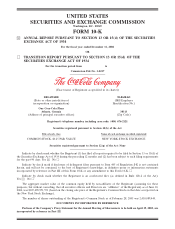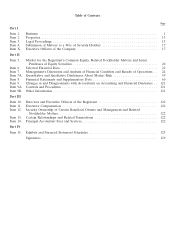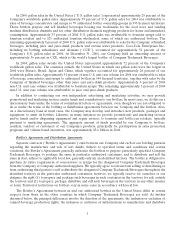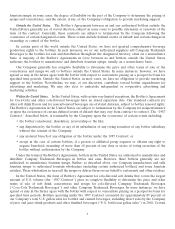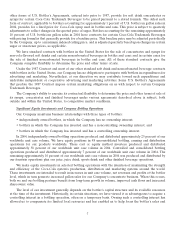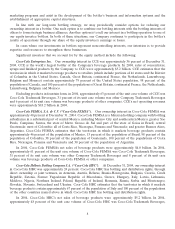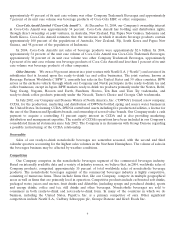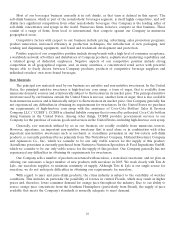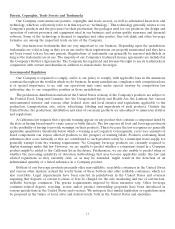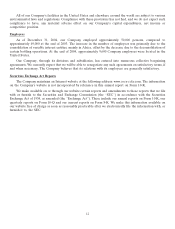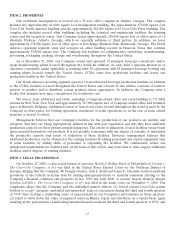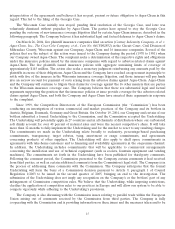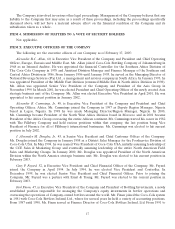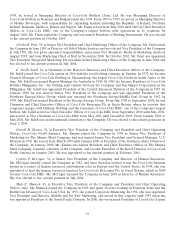Coca Cola 2004 Annual Report Download - page 10
Download and view the complete annual report
Please find page 10 of the 2004 Coca Cola annual report below. You can navigate through the pages in the report by either clicking on the pages listed below, or by using the keyword search tool below to find specific information within the annual report.marketing programs and assist in the development of the bottler’s business and information systems and the
establishment of appropriate capital structures.
In line with our long-term bottling strategy, we may periodically consider options for reducing our
ownership interest in a bottler. One such option is to combine our bottling interests with the bottling interests of
others to form strategic business alliances. Another option is to sell our interest in a bottling operation to one of
our equity investee bottlers. In both of these situations, our Company continues to participate in the bottler’s
results of operations through our share of the equity investee’s earnings or losses.
In cases where our investments in bottlers represent noncontrolling interests, our intention is to provide
expertise and resources to strengthen those businesses.
Significant investees that we account for by the equity method include the following:
Coca-Cola Enterprises Inc. Our ownership interest in CCE was approximately 36 percent at December 31,
2004. CCE is the world’s largest bottler of the Company’s beverage products. In 2004, sales of concentrates,
syrups and finished products by the Company to CCE were approximately $5.2 billion. CCE estimates that the
territories in which it markets beverage products to retailers (which include portions of 46 states and the District
of Columbia in the United States, Canada, Great Britain, continental France, the Netherlands, Luxembourg,
Belgium and Monaco) contain approximately 79 percent of the United States population, 98 percent of the
population of Canada, and 100 percent of the populations of Great Britain, continental France, the Netherlands,
Luxembourg, Belgium and Monaco.
Excluding products in fountain form, in 2004, approximately 63 percent of the unit case volume of CCE was
Coca-Cola Trademark Beverages, 31 percent of its unit case volume was other Company Trademark Beverages
and 6 percent of its unit case volume was beverage products of other companies. CCE’s net operating revenues
were approximately $18.2 billion in 2004.
Coca-Cola FEMSA, S.A. de C.V. (‘‘Coca-Cola FEMSA’’). Our ownership interest in Coca-Cola FEMSA was
approximately 40 percent at December 31, 2004. Coca-Cola FEMSA is a Mexican holding company with bottling
subsidiaries in a substantial part of central Mexico, including Mexico City and southeastern Mexico; greater S˜
ao
Paulo, Campinas, Santos, the state of Matto Grosso do Sul and part of the state of Goias in Brazil; central
Guatemala; most of Colombia; all of Costa Rica, Nicaragua, Panama and Venezuela; and greater Buenos Aires,
Argentina. Coca-Cola FEMSA estimates that the territories in which it markets beverage products contain
approximately 46 percent of the population of Mexico, 15 percent of the population of Brazil, 98 percent of the
population of Colombia, 38 percent of the population of Guatemala, 100 percent of the populations of Costa
Rica, Nicaragua, Panama and Venezuela and 30 percent of the population of Argentina.
In 2004, Coca-Cola FEMSA’s net sales of beverage products were approximately $4.0 billion. In 2004,
approximately 61 percent of the unit case volume of Coca-Cola FEMSA was Coca-Cola Trademark Beverages,
31 percent of its unit case volume was other Company Trademark Beverages and 8 percent of its unit case
volume was beverage products of Coca-Cola FEMSA or other companies.
Coca-Cola Hellenic Bottling Company S.A. (‘‘Coca-Cola HBC’’). At December 31, 2004, our ownership interest
in Coca-Cola HBC was approximately 24 percent. Coca-Cola HBC has bottling and distribution rights, through
direct ownership or joint ventures, in Armenia, Austria, Belarus, Bosnia-Herzegovina, Bulgaria, Croatia, Czech
Republic, Estonia, Former Yugoslavian Republic of Macedonia, Greece, Hungary, Italy, Latvia, Lithuania,
Moldova, Nigeria, Northern Ireland, Poland, Republic of Ireland, Romania, Russia, Serbia and Montenegro,
Slovakia, Slovenia, Switzerland and Ukraine. Coca-Cola HBC estimates that the territories in which it markets
beverage products contain approximately 67 percent of the population of Italy and 100 percent of the populations
of the other countries named above in which Coca-Cola HBC has bottling and distribution rights.
In 2004, Coca-Cola HBC’s net sales of beverage products were approximately $5.2 billion. In 2004,
approximately 48 percent of the unit case volume of Coca-Cola HBC was Coca-Cola Trademark Beverages,
8

